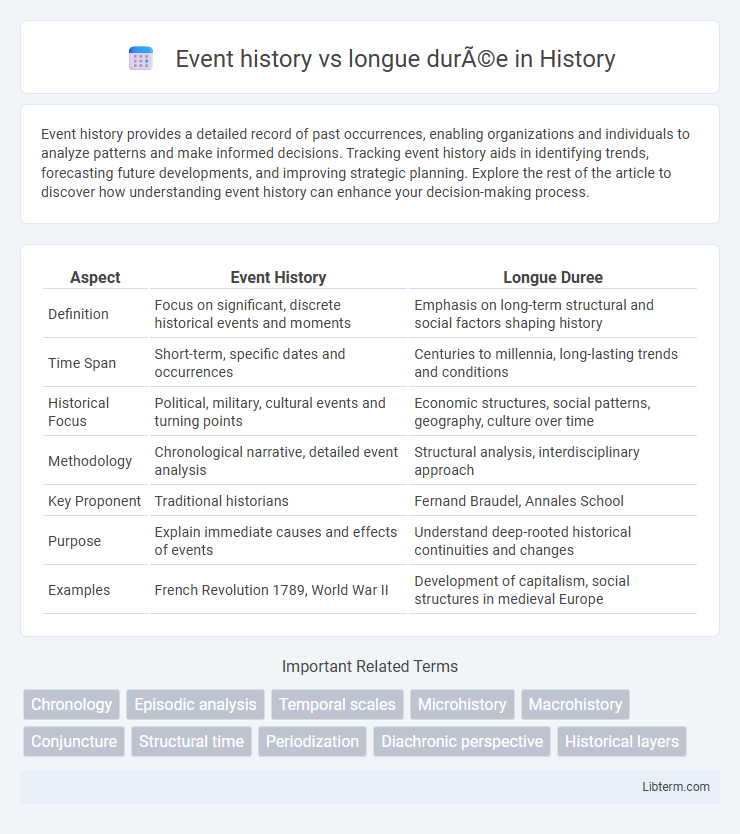Event history provides a detailed record of past occurrences, enabling organizations and individuals to analyze patterns and make informed decisions. Tracking event history aids in identifying trends, forecasting future developments, and improving strategic planning. Explore the rest of the article to discover how understanding event history can enhance your decision-making process.
Table of Comparison
| Aspect | Event History | Longue Duree |
|---|---|---|
| Definition | Focus on significant, discrete historical events and moments | Emphasis on long-term structural and social factors shaping history |
| Time Span | Short-term, specific dates and occurrences | Centuries to millennia, long-lasting trends and conditions |
| Historical Focus | Political, military, cultural events and turning points | Economic structures, social patterns, geography, culture over time |
| Methodology | Chronological narrative, detailed event analysis | Structural analysis, interdisciplinary approach |
| Key Proponent | Traditional historians | Fernand Braudel, Annales School |
| Purpose | Explain immediate causes and effects of events | Understand deep-rooted historical continuities and changes |
| Examples | French Revolution 1789, World War II | Development of capitalism, social structures in medieval Europe |
Defining Event History: Concepts and Approaches
Event history centers on analyzing discrete, significant occurrences and their immediate impacts within a historical timeline, emphasizing specific dates, actors, and turning points. This approach prioritizes cause-and-effect relationships and the chronological sequencing of events to understand historical change and continuity. It contrasts with longue duree by focusing on short-term dynamics rather than extended structural processes spanning centuries.
Understanding Longue Durée: Origins and Meaning
Longue duree, a concept developed by historian Fernand Braudel, emphasizes the study of historical structures and long-term social, economic, and environmental patterns that shape human events over centuries. Unlike event history, which focuses on short-term, discrete occurrences and significant dates, longue duree investigates persistent trends and underlying forces that influence societies beyond immediate happenings. This approach reveals the deep-rooted causes and enduring frameworks that contextualize historical change within sustained temporal dimensions.
Key Differences between Event History and Longue Durée
Event history centers on specific occurrences and their immediate effects within a defined timeframe, emphasizing precise dates and chronological sequences. Longue duree analyzes overarching social, economic, and cultural structures persisting over centuries, highlighting gradual changes and deep-rooted patterns. The key difference lies in event history's focus on short-term, discrete incidents versus longue duree's emphasis on long-term, structural continuity and slow transformation.
Theoretical Foundations: Historiography and Methodology
Event history emphasizes detailed analysis of individual occurrences within a specific timeframe, relying on primary documents to reconstruct causal sequences and chronological narratives. The longue duree approach, rooted in Annales School historiography, prioritizes long-term social, economic, and environmental structures over transient events, advocating for interdisciplinary methodologies incorporating geography, anthropology, and sociology. Methodologically, event history applies micro-level analysis linked to temporal specificity, while longue duree employs macro-historical perspectives that reveal persistent patterns influencing historical change.
Case Studies: Event History in Practice
Event history focuses on analyzing specific incidents over short time frames to uncover detailed causal relationships, enhancing understanding of immediate social dynamics. Case studies in event history reveal patterns and consequences of distinct occurrences, such as political uprisings or economic crises, by closely examining timelines and individual experiences. This approach contrasts with longue duree, emphasizing micro-level changes and contextual specificity through detailed chronological analysis.
Examining Longue Durée through Historical Examples
Examining longue duree through historical examples reveals patterns of social, economic, and cultural structures that persist over centuries, shaping events beyond immediate occurrences. This approach contrasts with event history by emphasizing slow-moving forces like geography, institutions, and long-term demographic trends that influence historical change. Analyzing cases such as the persistence of feudal systems or the impact of climate on civilizations highlights the endurance of underlying structures across time.
Strengths and Limitations of Event-Based Analysis
Event-based analysis excels in capturing specific, discrete occurrences with precise chronological detail, offering clear causal relationships and immediate impacts within historical narratives. Its strength lies in detailing pivotal moments that shape outcomes, yet it often overlooks broader, slower-changing social, economic, and cultural processes addressed in longue duree approaches. This limitation can result in fragmented interpretations that miss underlying structural patterns and long-term historical continuities.
Longue Durée’s Impact on Historical Interpretation
Longue duree emphasizes the analysis of enduring structures and long-term historical patterns over episodic events, reshaping historical interpretation by prioritizing deep-rooted social, economic, and environmental factors. This approach challenges traditional event-focused historiography by highlighting persistent trends like climate change, demographic shifts, and institutional evolutions that shape societies over centuries. Consequently, longue duree fosters a more comprehensive understanding of historical causality that reveals underlying continuities beyond transient occurrences.
Integrating Event History and Longue Durée Approaches
Integrating event history and longue duree approaches enhances historical analysis by combining detailed chronological data with long-term structural patterns, enabling a deeper understanding of sociopolitical and economic transformations. Event history methods provide granular insights into specific occurrences and turning points, while the longue duree perspective reveals persistent underlying forces shaping historical trajectories over centuries. This synthesis facilitates comprehensive interpretations that bridge immediate events with enduring historical contexts, improving explanatory power in historical research.
Future Directions in Historical Research Methods
Future directions in historical research methods emphasize integrating event history analysis with longue duree perspectives to capture both short-term occurrences and long-term structural changes. Advances in digital humanities and big data enable historians to analyze massive datasets, revealing patterns across extended timeframes while maintaining detailed event-level granularity. Emerging methodologies prioritize interdisciplinary approaches, combining quantitative event history models with qualitative longue duree narratives to enhance understanding of complex historical dynamics.
Event history Infographic

 libterm.com
libterm.com